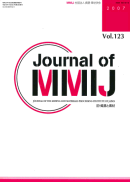Volume 123, Issue 12
Displaying 51-69 of 69 articles from this issue
Technical Report
-
2007 Volume 123 Issue 12 Pages 784-787
Published: December 25, 2007
Released on J-STAGE: December 17, 2010
Download PDF (1787K) -
2007 Volume 123 Issue 12 Pages 788-792
Published: December 25, 2007
Released on J-STAGE: December 17, 2010
Download PDF (1468K) -
2007 Volume 123 Issue 12 Pages 793-795
Published: December 25, 2007
Released on J-STAGE: December 17, 2010
Download PDF (1751K) -
2007 Volume 123 Issue 12 Pages 796-798
Published: December 25, 2007
Released on J-STAGE: December 17, 2010
Download PDF (2103K) -
2007 Volume 123 Issue 12 Pages 799-802
Published: December 25, 2007
Released on J-STAGE: December 17, 2010
Download PDF (1229K) -
2007 Volume 123 Issue 12 Pages 803-805
Published: December 25, 2007
Released on J-STAGE: December 17, 2010
Download PDF (1544K) -
2007 Volume 123 Issue 12 Pages 806-810
Published: December 25, 2007
Released on J-STAGE: December 17, 2010
Download PDF (2306K) -
2007 Volume 123 Issue 12 Pages 811-813
Published: December 25, 2007
Released on J-STAGE: December 17, 2010
Download PDF (1158K) -
2007 Volume 123 Issue 12 Pages 814-818
Published: December 25, 2007
Released on J-STAGE: December 17, 2010
Download PDF (3549K) -
2007 Volume 123 Issue 12 Pages 819-822
Published: December 25, 2007
Released on J-STAGE: December 17, 2010
Download PDF (1284K) -
2007 Volume 123 Issue 12 Pages 823-827
Published: December 25, 2007
Released on J-STAGE: December 17, 2010
Download PDF (1555K) -
2007 Volume 123 Issue 12 Pages 828-831
Published: December 25, 2007
Released on J-STAGE: December 17, 2010
Download PDF (1501K) -
2007 Volume 123 Issue 12 Pages 832-835
Published: December 25, 2007
Released on J-STAGE: December 17, 2010
Download PDF (1370K) -
2007 Volume 123 Issue 12 Pages 836-838
Published: December 25, 2007
Released on J-STAGE: December 17, 2010
Download PDF (1450K) -
2007 Volume 123 Issue 12 Pages 839-840
Published: December 25, 2007
Released on J-STAGE: December 17, 2010
Download PDF (1062K) -
2007 Volume 123 Issue 12 Pages 841-843
Published: December 25, 2007
Released on J-STAGE: December 17, 2010
Download PDF (956K)
5.The Present and issues of Iron, Aluminum and Coment Industries
Technical Report
-
2007 Volume 123 Issue 12 Pages 845-849
Published: December 25, 2007
Released on J-STAGE: December 17, 2010
Download PDF (1751K) -
2007 Volume 123 Issue 12 Pages 850-854
Published: December 25, 2007
Released on J-STAGE: December 17, 2010
Download PDF (4445K) -
2007 Volume 123 Issue 12 Pages 855-859
Published: December 25, 2007
Released on J-STAGE: December 17, 2010
Download PDF (2324K)
